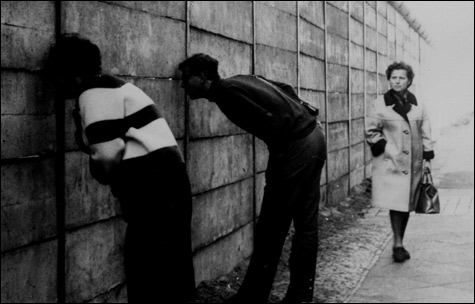
FAULT LINES: Taylor traces the history of the divided city to its very beginnings. |
In the center section of Frederick Taylor’s 508-page book about the Berlin Wall, there’s a November 1989 photograph of rows of Berliners straddling the high cement barrier. One man stands on the Wall, his hands making peace signs in the air. It’s the obverse of the famous image of Peter Fechter taken in August 1962: a young man dying beneath knots of barbed wire. Taylor’s overstuffed narrative tells the history of the Wall, in all its paradoxes. As he quotes a unnamed drinker in an East Berlin bar, just after the Wall came down: “So . . . they built the Wall to stop people leaving, and now they’re tearing it down to stop people leaving. There’s logic for you.”
Beginning with “Marsh Town,” Taylor describes a city that was conceived as two large villages on opposing sandy banks of the river Spree. His chronology of the built-up marshland reads like a draconian catalogue. Sweden’s King Gustavus Adolphus (1594–1632) brought to Berlin the “Swedish drink” — a form of torture that involved pouring raw sewage down victims’ throats. During World War I, “rats became candidates for Berlin’s dinner tables,” and the aftermath of World War II — though called the “golden hunger years” — brought the price of sex with a German woman down to a mere five cigarettes. Taylor’s intro is macabrely well done, and so is its thesis that Berlin had already been badly broken before tensions between post-WW2 allies sandbagged it into two halves.
At the onset of the Cold War, in the mid 1940s, Berlin became two opposing banks once again. The night of August 12, 1961, the leaders of Walter Ulbricht’s German Democratic Republic attended a garden party at Döllnsee — formerly the hunting grounds of Hermann Göring. Sequestered safely north of the city, the men who dreamed up the Wall waited for morning — when East Berliners would wake to “Barbed-Wire Sunday.” Ulbricht’s divided city came true overnight. So did the capitalist West’s worst nightmare. Cue the ensuing “Wall Games,” which read like Taylor’s little-known spy novel Walking Shadows.
Ulbricht, Willy Brandt, and John F. Kennedy become the dramatis personae in “a figment of somebody’s mad imagination” — which is how Taylor admits to sometimes thinking about the GDR’s “anti-fascist protective rampart.” Said rampart was intended to stop East Berliners from leaving; once it was built, they were frantic to leave. The first lot jumped out of windows in the East into parachutes in the West held by civilians and firemen. Later, they would attempt to send trains, trucks, and even homemade balloons through the guard-laden barrier. As the Wall became more impenetrable, the matter of leaving turned professional — e.g., Hasso Herschel’s DM 50,000 (equal to approximately $100,000 today) tunnel, which was financed by NBC in exchange for exclusive film rights.
Then, within a handful of years, East Berliners stopped trying. “The inherently abnormal border situation had become, in effect ‘normal’ — proof, if anyone needs it, that people will get used to just about anything over time.” The life of the Wall between the late ’60s and the late ’80s is recounted in a few short chapters, and if you want to learn about it as a medium for artists like Keith Haring and Thierry Noir, you’ll have to look elsewhere — John Gossage’s photographic study Berlin in the Time of the Wall, for one.